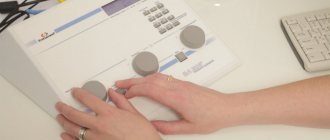- home
- Helpful information
- Analyzes and examinations
- Types of instrumental examinations
Instrumental diagnostic methods are used for routine and preventive examinations, to identify diseases, to control their course, and to evaluate the effectiveness of therapy.
For them, special equipment is used, which allows you to assess the condition or operation of a particular organ or system. Medical uses the following types of instrumental examinations in diagnosis. Sign up for a consultation
Radiography and fluoroscopy
In radiography, X-ray beams are passed through to produce a two-dimensional image of organs and tissues. Images are formed due to differences in the ability of different tissues to absorb radiation. The study is used mainly in traumatology, orthopedics, and to assess the condition of the skeleton.
Fluoroscopy also uses x-rays, but with its help, not individual images are taken, but long-term shooting. Used to visualize heart rate, intestinal motility, passage of an injected contrast agent through the esophagus, etc. Fluoroscopy is rarely used due to the relatively high doses of x-ray radiation. If possible, ultrasound or other research methods are used instead.
Diagnostic research methods
People often ask the question, which diagnostic method is the most accurate? Is it possible to answer this unambiguously? To do this, let's look at what diagnostic methods generally exist.
Without delving into medical terms, we can divide all diagnostic research methods into three groups.
The first include anatomical, that is, those studies that use visual observation of any organ. These include: x-ray, fluorography, ultrasound, computed tomography and magnetic resonance imaging, endoscopy, laparoscopy. This also includes a visual examination by the doctor of the patient: examination of the tongue, throat, skin, etc.
All these studies have the following in common. The doctor sees the organ, its size, position, shape and anatomical defects (stones, cysts, ulcers, tumors, ulcers...)
The second group includes all laboratory research methods. They examine the chemical and physical processes in our body and identify abnormalities at these levels.
For example, an ultrasound of the pancreas did not reveal anything, and a blood test showed an increase in blood glucose levels. This means that we can already diagnose the disorder, and at an early stage.
The third group of diagnostic studies are functional methods, that is, those that determine whether an organ is performing its function normally. Of all the known ones, this group includes ECG (heart function) and EEG (brain function), although an electrical impulse can be removed from almost any organ.
Diseases do not appear overnight; they develop over years and go through several stages.
At first, the disruption of the functioning (function) of the organ is not noticeable, we do not feel any problems, the tests are normal, the pictures are also normal.
Then unpleasant symptoms may appear - a little tingling, sipping, and not always. In a few years, we will see a reflection of the dysfunction of the organ in the test results. If no measures are taken here, then after some time we will see the problem visually, that is, on ultrasound, CT, MRI and other anatomical studies.
For example, first the iliac region is pulled, then signs of inflammation appear in tests, then we find a cyst in the ovary.
Now let's return to the main question of the article - is there a single, most accurate diagnostic method? It’s probably already clear that no. Different disorders in the body are recorded using different methods. And the final diagnosis (not only the disease, but also its stage) can only be made based on the results of a combination of studies. And some methods do not replace others.
It is also clear that the earlier we detect a problem, the easier it is to solve it. Therefore, you should not neglect the recommendations of doctors and conduct research with some frequency. And also do not forget to exercise your right to undergo medical examination once every 3 years, which will help to identify ailments at an early stage, and therefore prevent the development of serious diseases.
Ultrasonography
Performed using an ultrasound machine. The equipment registers the reflection and passage of ultrasonic waves, which makes it possible to obtain an image of an organ, evaluate the structure of tissues, their density, identify structural changes, etc. Ultrasound is widely used in diagnostics to assess the condition of internal organs. The study provides a large amount of information, allows you to prescribe an optimal treatment plan or adjust previously proposed therapy. It is used to study the abdominal organs, thyroid gland, genitourinary system, etc. The procedure is painless, non-invasive and takes a few minutes. It is safe and can be performed an unlimited number of times.
Indications for examination
Laboratory diagnostics are always used, regardless of the type of diseases and disorders in the body. However, tests are prescribed individually in each case, based on the purpose of the examination.
General clinical. They have a wide range of applications. Prescribed for diagnosing diseases, during various medical examinations, examinations before operations.
Biochemical. They are carried out to identify disturbances in the functioning of internal organs and metabolic processes, as well as to assess the degree of their severity.
Hormonal. They are carried out for endocrine pathologies, menstrual irregularities, infertility, erectile dysfunction, obesity, hair loss, skin problems.
Immunological. Indicated for autoimmune diseases, the development of oncological processes, chronic infections, allergic reactions, as well as during preparation for surgery and internal organ transplantation.
Genetic. They are carried out to assess the state of the reproductive system, determine the Rh factor, study hereditary immunity factors, and blood clotting indicators. The examination is relevant if there is a risk of “inheritance” of serious illnesses affecting the nervous, digestive, and cardiovascular systems, including alcohol and drug addiction.
Infectious. The biomaterial is studied to identify any infections and viruses, for example, herpes, rubella, rotavirus. This includes sexually transmitted diseases.
Important! The objects of research are blood, the contents of cavities and infiltrates, physiological secretions (saliva, sputum, feces, sperm), tissue samples of various organs, nail plates, and hair.
Electrocardiography
Amplification and recording of electrical impulses of the heart. After registration, data on the characteristics of these pulses are transferred to paper in the form of a group of broken curves. Each of them characterizes the activity of a particular department or structure of the heart. Used to detect heart rhythm disturbances, problems with blood supply to the heart, complications after a heart attack, etc. The study is painless; during it, several sensors are attached to the patient’s chest, arms, and legs. The procedure takes a few minutes. It is possible to conduct a daily ECG (extended examination during the day), take an ECG under load or after taking certain medications.
Types of laboratory diagnostics
Of the many types of laboratory diagnostics, the most popular are:
- General clinical. The physicochemical properties of blood, urine, feces, genital secretions, and cerebrospinal fluid are studied.
- Hematological. A set of laboratory tests that allows you to obtain information about quantitative and qualitative blood parameters.
- Biochemical. One of the most important tests that allows you to quickly identify abnormalities in the functioning of internal organs.
- Cytological. Designed to detect malignant tumors.
- Hormone. Allows you to determine the level of hormones from venous blood and urine.
- Bacteriological. It is used to determine the body's sensitivity to a particular type of antibiotic.
- Serological. Helps identify antibody titers to various pathogens.
Another diagnostic method that is relevant at all times is PCR. Allows you to accurately detect the presence of DNA of viruses and bacteria in the body.
Magnetic resonance imaging
This diagnostic method uses a magnetic field to obtain high-resolution images of internal organs or tissues. For the examination, a device with a camera is used, inside which the patient is located. This device provokes an electromagnetic response from atomic nuclei. The response is recorded and translated into a two-dimensional or three-dimensional image.
MRI allows you to obtain layer-by-layer images of organs and tissues. Used in the diagnosis of diseases of the spinal cord, brain, and internal organs. Gives high accuracy. The procedure takes about half an hour, it is painless, but is not suitable for people with a fear of closed spaces. Not used for diagnosing heart disease.
Medical Internet conferences
The medical diagnostic process can be considered as a specific cognitive process. Medical diagnostics is the process of establishing a diagnosis, that is, a conclusion about the nature of the disease and the patient’s condition.
Diagnostics is an area of subjective-objective relations. In medical diagnostics, the subject can be either a professional doctor with knowledge and skills, or the patient himself with his own mental characteristics and lifestyle. Philosophy affirms the active, active role of the subject in the process of cognition. His activity consists of searching for new ideas, putting forward hypotheses, creating theories, testing them in practice, and using them.
Knowledge of dialectics, its categories, principles and laws plays an important role in diagnosis. The categories of individual, special and general are used in diagnosis. They focus on searching for something specific in a phenomenon. The process of cognition begins with the individual, and from there to the particular and the general. Thus, in the diagnostic process, symptoms are first identified, which are then combined into syndromes, and on the basis of this a conclusion is made about the disease.
Categories of essence-phenomenon raise the problem of symptoms and pathogenesis. The doctor makes the transition from knowledge of phenomena to essence. Symptoms are phenomena, disease is an entity. It is important to take into account that the essence never appears in its pure form; the phenomenon includes not only the essence, but also the accidental, that is, moments that do not follow from the essence itself. During the diagnostic process, the doctor takes this into account, for example, when a patient complains of suffocation, it should be understood that this symptom can relate not only to diseases of the respiratory system, but also to the cardiovascular system.
Diagnostic activity is based on the laws of formal logic.
The requirements of the law of identity are that the concept of the subject of research (for example, a symptom, a disease) must be precisely defined and unambiguous. In diagnostic practice, compliance with the law of identity requires clarity and specificity. Currently, more and more new diseases are appearing, and accordingly new names are appearing. The law of identity requires constant updating and clarification of the international and national nomenclature of nosological forms and classifications of diseases.
According to the law of contradiction, two opposing judgments about the same subject, considered under the same conditions, cannot be simultaneously true. An example of the application of the law of contradiction could be the denial of one of two preliminary diagnoses based on the results of laboratory and instrumental studies.
The law of exclusion of the middle, which follows from the law of non-contradiction, states that two contradictory statements about the same subject at the same time and relative to each other cannot be true and false together. In this case, out of two judgments, one is chosen - the true one, since there is no intermediate judgment, which must also be true. For example, pericarditis can be either the underlying disease or only a complication of other diseases.
The Law of Sufficient Reasons states that every new conclusion must be based on a proposition that has already been proven to be true. A doctor can make a diagnosis based on objective data from laboratory and instrumental studies, knowing existing standards and reference values.
Intuition plays an important role in the diagnostic process. They largely determine the correctness of the diagnosis. Intuition is the ability to comprehend the truth without relying on evidence. The diagnostic process is a creative process. A creative approach helps the doctor in diagnosing diseases, because many diseases occur atypically, many symptoms can be observed in a number of diseases. Rational and non-rational forms of cognition make it possible to make both a nosological diagnosis and a pathogenetic diagnosis characteristic of a specific patient with a more correct prognosis of the disease, based on the general cognitive pattern of ascent from the abstract-logical to the concrete, mental reproduction of it.
Thus, the medical diagnostic process as a specific cognitive process involves recognizing a disease with penetration into its hidden essence, establishing its signs, content, structure and dynamics.
Electroencephalography
Method for assessing electrical activity of the brain. The procedure is carried out in several stages; the examination plan can be drawn up individually. To record brain activity, sensors are attached to the patient's head. Electrical activity is read at rest. Next, the EEG is carried out using additional stimuli (rapid breathing, flashes of light, etc.).
The result of the examination is a set of broken lines reflecting the activity of different parts of the brain. Based on their structure, epilepsy, age-related changes, and disorders of the brain are diagnosed.
Endoscopy
The study is performed using an endoscope - an instrument with a flexible fiber-optic tube with a diameter of 8 to 15 cm. It allows you to “see” organs from the inside, obtain an image of the bronchial mucosa, stomach, etc.
Some equipment allows you to take tissue samples during the study. Endoscopes are used in gastroenterology, pulmonology, urology and gynecology, cardiology, etc. You have questions?
We will call you back within 30 seconds
or call the number
Clicking the "Submit"
, you automatically consent to the processing of your personal data and accept the terms of the User Agreement.
- Preventative medical examination for the elderly
- Types of instrumental examinations
- Laboratory diagnostics: main types of tests
- Examination by a neurologist and psychiatrist for the diagnosis of dementia and Alzheimer's disease
Indications and contraindications for functional diagnostics
The main indication for functional diagnostics is a suspicion of dysfunction of a particular organ. Regular ECG is recommended for all adults. Certain types of functional diagnostics are prescribed during medical examinations for certain categories of workers. Due to the harmlessness of most functional diagnostic methods, they have virtually no contraindications.
You can sign up for an examination in Volgograd, Volzhsky and Mikhailovka at the DIALINE clinics. To do this, use your personal account on our website. We carry out such studies as ECG, 24-hour blood pressure monitoring, 24-hour electrocardiogram monitoring, reencephalogram, spirometry, and audiometry. Our offices are equipped with advanced technical equipment, which, combined with extensive experience and professionalism of the staff, allows us to conduct examinations with high accuracy.





